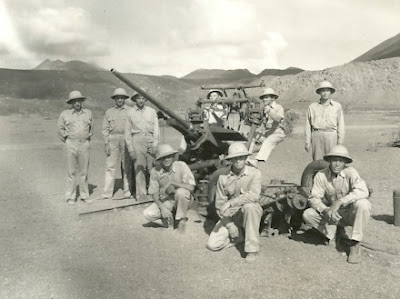"Use of Ascension Island is Badly Kept Secret"
by
Peter Edson
Newspaper Enterprise Association
Washington Correspondent
December 30 1943
"Use of 34-square-mile Ascension Island as a U.S. air base at last can be talked about. For more than a year, this tiny British island, 300 miles south of the equator in the middle of the South Atlantic Ocean, has been a stopping point for short-range fighter planes being ferried to Southern Europe and African fronts, and even to the Middle and Far East.
"It is perfectly situated for such use, being approximately 1500 miles east of Natal on the Brazil bulge, and equidistant from American and British air bases on the southern coast of the African bulge.
"Its selection as a refueling base for the Air Transport Command came in fact, after the generals running the ATC wished that they had such a halfway base, then looked at the map to see that Ascension Island was right where they wanted it. With auxiliary fuel tanks, fighter planes could make the South Atlantic crossing in two hops easily. But the island was a British possession. That meant making a deal with the British, which proved far easier than the next obstacle encountered, the fact that the island was volcanic with 2000-foot Green Mountain rising in the middle, an extremely irregular lava rock terrain cut by deep gorges, and no place level or big enough for an airport.
"That did not stop the engineers who were given the job of building a field in 90 days. Eighty-seven days later a minor peak that loomed up in the middle of the runway which the engineers mapped out, had been removed. In its place was a beautiful, 7000-foot, hard-surfaced landing strip that has accommodated hundred of American planes on their way to the fronts.
"Use of Ascension as a U.S. air base has been one of the Army's worst-kept secrets. When Gen. George C. Marshall's biennial reports was issued last Summer, it revealed that U.S. troops then were stationed in some 80 foreign countries and island possessions. On a map accompanying the report, showing where all these places were, the name of little Ascension stood out prominently in the South Atlantic. A legend indicated that U.S. troops had been stationed there since March 1942. [RC note: that is when my father arrived with the 38th Engineers.]
(One of the reasons for the secrecy about the U.S. air base on Ascension was--because U.S. troops were so overtaxed at the beginning of World War II--this important but isolated runway was badly defended at first by a thin group of British troops with out-of-date equipment. It wasn't until America was able to land a viable group of infantry on the island that the fact of the base could be acknowledged.)
"Everything in the Marshall report was supposed to be off the restricted list and on the record, but efforts to learn more about what went on at Ascension met with flat refusals. Ascension was supposed to be a very hush-hush operation and the Air Transport Command didn't want anything said about it.
"Even though the Marshall report had lifted the lid and even though anyone looking at a map could guess what it was being used for, still, even the simplest announcement about a U.S. base on Ascension had to be kept "secret."
"Then, a few days ago, a luncheon-club speaker in Washington, in full possession of all the facts, talked freely about Ascension and said it was all right for the story to be told, without attribution. That's how it got out.
"The Air Transport Command will issue a handout release about the island to coincide with publication of a magazine article which tells all in greater detail.
"But this won't be the end of the Ascension Island story. Being another one of these American-built-paid-for-and-maintained bases on British territory, it will become a topic for argument in deciding its postwar use. The strong nationalist point of view is that all such bases, wherever built, should remain as American bases.
U.S.-built military air bases at Newfoundland, Bermuda and other points involved in the swap of old destroyers to the British will remain under the American flag during the 99-year lease, but cannot be used for commercial aircraft.
"Some of the leading commercial airline executives are of the opinion that this is unimportant, because most of these bases are not on what will be the commercial postwar air routes. Ascension Island, before the war, certainly was no great asset except for the millions of terns and sea turtles which went there to lay eggs. Its human population numbered 300 mostly living in the one community of George Town [sic].
"But it's an important air base now, and it's no longer a secret and what's to be done about it and the hundreds more like it, in the postwar by-and-by, is a free topic for debate."
On Wideawake Field's 50th anniversary, British writer Duff Hart-Davis sent my father a postcard from the island, writing: "Well--I made it! I'm sorry to say your runway is cracking up at last. But everyone reckons you did a great job. I got a very nice reception from trans command. Wish you were here, Duff." Hart-Davis' book Ascension: The Story of a South Atlantic Island, is excellent.




No comments:
Post a Comment